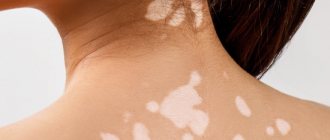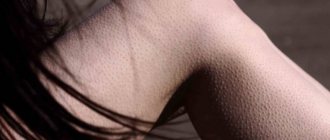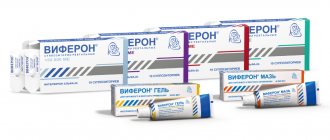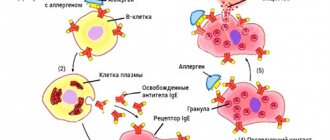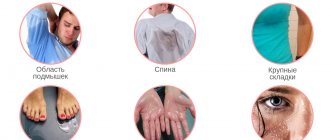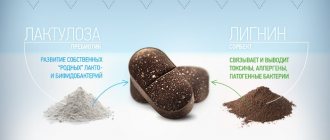Allergic rhinitis is radically different from a runny nose, which occurs with viral infections. With this disorder, inflammation develops due to an overly vigorous immune response to an irritant that has reached the mucous membrane. Most often, the problem is provoked by allergens that come in the air, and therefore the body cannot cope with the problem without treatment, since the irritant acts constantly for a long time. When treating the disease, drops for allergic rhinitis are widely used, which not only make breathing easier by relieving nasal congestion, but also help eliminate the main unpleasant symptoms of the pathology. The idea that a disease is harmless is a deep misconception that can seriously undermine your health. It is not only possible to treat allergic rhinitis, but it is absolutely necessary.
Allergic rhinitis is a fairly common pathology that can appear at any age in both sexes. The maximum number of patients occurs in the preschool period, when the child’s body is actively confronted with various new stimuli and learns to respond to them adequately. It is wrong to think that the baby will outgrow such a problem. The disease must be treated, otherwise it will become chronic. If therapy is carried out, the disorder will go away and may no longer appear at all, since the body will respond correctly to the irritant substance. In adults, allergic rhinitis, as a rule, does not go away completely and recurs periodically under the influence of a substance that is not tolerated by the body. All allergic rhinitis is divided into seasonal and year-round. The first are those that occur due to exposure to seasonal allergens, such as pollen and plant seeds, and the second are those that are constantly present, like the irritant that causes them. Most often, year-round rhinitis appears due to dust, wool or harmful emissions from production in the area of residence.
What drops are used in treatment
When treating the disease, nasal drops of several categories are used. What a particular patient needs is determined only by the doctor after assessing the patient’s condition. When prescribing treatment, the patient’s age and general condition must be taken into account. Drops for allergic rhinitis are formulations that are not as common and numerous as sprays, but still deserve attention. All drugs are divided into four categories:
- antihistamine nasal drops - their action is aimed directly at eliminating the allergic reaction to the nasal mucosa. These remedies are effective and can not only relieve the symptoms of the disease, but also prevent its development in the case of seasonal rhinitis. To do this, they are used for preventive purposes during the presence of the allergen, starting several days before the expected date of its appearance;
- reducing the production of histamine - these drugs help prevent the occurrence of allergies, but they are not effective enough to treat already developed rhinitis. Drops are prescribed primarily to prevent exacerbations of seasonal rhinitis, and they are a prophylactic agent;
- hormonal anti-inflammatory - they have a less aggressive effect on the body than systemic drugs in this category, and at the same time they allow you to quickly eliminate swelling of the mucous membrane and relieve its inflammation, which is necessarily present in allergic rhinitis. These medications may not be prescribed to everyone and have many contraindications;
- vasoconstrictors - prescribed for emergency relief of swelling of the mucous membrane. They can only be used for a short period, as otherwise addiction to them may occur, which is an extremely negative phenomenon. This category of drops is prescribed only as an adjuvant in complex therapy. Old generation drugs can be used without harm for no more than 5 days, and new ones for up to 7-10 days.
It is not uncommon for doctors, in addition to drops for allergic rhinitis, to also prescribe systemic medications that speed up the process of eliminating the allergic reaction. Such drugs combine well with products for topical use and in most cases do not cause a negative reaction from the body.
Combination therapy for allergies
Treatment of allergies, including allergic rhinitis, involves an integrated approach that uses sprays for allergic rhinitis in combination with anti-inflammatory nasal medications (sprays or drops for allergies or allergic rhinitis in the nose), as well as eye drops and glucocorticoids - depending on the doctor's orders.
The decision on the form of release of the antihistamine and the combination of drugs remains with the doctor and is based on individual characteristics - the severity of the reactions, the age of the patient, etc. Particular care should be taken when choosing a drug complex and allergy spray for the treatment of rhinitis in children.
The information in this article is for reference only and does not replace professional advice from a doctor. To make a diagnosis and prescribe treatment, consult a qualified specialist.
LITERATURE:
- Nenasheva N.M. Therapy for allergic rhinitis: which antihistamine to choose? Federal State Budgetary Educational Institution of Further Professional Education RMANPO of the Ministry of Health of Russia, Moscow. Russian medical journal from 05.20.2015 (9): 514.
- Hideyuki Kawauchi, Kazuhiko Yanai, De-Yun Wang et al. Antihistamines for allergic rhinitis treatment from the viewpoint of nonsedative properties. International Journal of Molecular Sciences. 2022 Jan; 20(1):213. Hideyuki Kawauchi, Kazuhiko Yanai, De-Yun Wang, et al. Antihistamines for the treatment of allergic rhinitis in terms of non-sedative properties.
Antihistamine drops
Almost all drops with an antihistamine effect have general contraindications for use. Drugs from this category are not prescribed for therapy in the following cases:
- age less than 15 years;
- pregnancy period;
- breastfeeding period;
- the presence of atrophic rhinitis;
- diabetes;
- atherosclerotic changes in the vessels of the nasal mucosa;
- drug intolerance.
Drops against allergic rhinitis are one of the most popular means for treating the problem in adults. They allow you to get rid of all the main manifestations of pathology, not only eliminating swelling, but also stopping the flow from the nose. It will not be possible to cure the disease completely without the use of systemic antiallergic drugs, but antihistamine drops can significantly alleviate its course.
The most popular drugs in this category are the following:
- Sanorin Analergin is a popular remedy that effectively stops nasal flow and eliminates swelling. Drops also help get rid of itching and burning in the nose;
- Tizin Alergy drops have significant contraindications and should only be prescribed by a doctor. It is highly undesirable to choose them for therapy on your own;
- Allergodil eye drops - they can be instilled into the nose to relieve itching and burning. A spray is available directly for nasal use;
- Histamet is one of the few nasal antiallergic drugs that is considered completely harmless and not absorbed into the bloodstream. Its use is allowed even in pregnant women, but only under medical supervision and as prescribed by a specialist.
Drops in this category relieve symptoms of the disease in a short period of time and can be used for a long time.
Medicines against rhinitis
Top drugs are presented:
- Isofray – suitable for complex treatment of bacterial diseases, preventive treatment and postoperative period. Do not use for damage to the nasal sinuses or intolerance to the component composition. The medicine is not prescribed to children under the first year of life, pregnant and lactating women. Therapy should not exceed 10 days; the medication is not suitable for nasal rinsing.
- Nazivin - suppresses the clinical signs of vasomotor and allergic rhinitis, runny nose with influenza, relieves swelling of the mucous membrane after operations or diagnostic examinations. It is prohibited to take for diseases of the cardiovascular system, glaucoma, arterial hypertension. Allowed for pregnant and lactating women - as prescribed by a doctor.
- Siarol - made in the form of a spray and drops, does not require a doctor's prescription. A medicine with an antiseptic and astringent effect, when used, it covers the nasal passages with a protein film that prevents the penetration of pathogenic microflora. Used to combat sinusitis, sinusitis, runny nose, pharyngitis. Can be used to prevent discomfort that occurs in dry air. The disadvantages of Siatrol include the risk of irritation.
Excessive use of anti-runny nose drops can cause dry mucous membranes, allergic reactions, and increase blood pressure.
Vasoconstrictors
They are needed only as an aid that will restore normal nasal breathing within a few minutes even before the antiallergic drug begins to act. Such drops affect the walls of blood vessels located in the nasal mucosa and stimulate them to contract. With prolonged use of the medicine, addiction develops and the blood vessels stop working on their own, not narrowing without the stimulant. Because of this, congestion becomes permanent if instillation is not carried out. To avoid such a negative effect from the treatment, it is imperative to know and not exceed the maximum permissible duration of use of the vasoconstrictor medication. The most commonly used drops from this category are: Naphthyzin, Vibrocil, Nazivin. In cases where prolonged use of vasoconstrictor drugs is required, it is recommended to alternate drops with different bases. Also in this situation, it is necessary to consult a doctor about how to prevent addiction to the drug and the development of dependence on the drops.
Antiallergic drugs
Common means include:
- Allergodil - intended for the treatment of seasonal allergies, year-round runny nose of non-allergic etiology, rhinoconjunctivitis. After the procedures, there is a decrease in swelling, itching, frequency of sneezing, and mucous secretion. There is no addiction to the drug, but side effects may occur: attacks of dizziness, irritation. The medicine cannot be used during pregnancy and breastfeeding, for a baby under 6 years of age.
- Afrin Clean Sea is a natural solution of sea water, used as a cleanser of the nasal mucosa from pathogenic microflora and allergens. Treatment allows you to normalize breathing and moisturize the membranes. Approved for patients of any age; it contains no artificial additives.
- Dyrenitis - prescribed to patients over 2 years of age during seasonal allergies or as an additional medication for acute sinusitis and antibacterial therapy (after 12 years). Only adult patients are allowed to treat polyposis. The medicine has an anti-inflammatory effect; disadvantages include the risk of allergies, prohibition of use in case of nasal injuries or after surgery.
- Tizin Alergy is used to relieve clinical manifestations of allergic rhinitis. Allowed for therapy of children over 6 years of age and adults, procedures are performed 2 to 4 times a day.
The list ends with Cromohexal, which helps cope with allergic rhinitis and is used to prevent the development of hay fever. The product has a prolonged effect, withdrawal is carried out gradually, with a decrease in the initial dosage. The disadvantages of the medicine include nosebleeds, coughing, and headaches.
Types of eye allergies
There are a wide variety of forms of eye allergies, the most common of which are allergic dermatitis and conjunctivitis. But it should be noted that an allergic reaction can affect all structures of the eye and cause damage to them, for example, keratitis (inflammation of the cornea), papilledema, uveitis, etc. An allergic process in the eyes or eyelids can be either an independent disease (a reaction to the ingestion of cosmetics, medications, or be a manifestation of a systemic disease (hay fever, etc.).[1]
Fig. 1 Manifestation of allergies in the eyes: conjunctivitis, blepharitis and their combination (blepharoconjunctivitis)
Histamine and histamine receptors
Histamine is one of the most important mediators, belonging to biogenic amines and synthesized from the amino acid histidine by decarboxylation. In the human body, histamine performs a number of physiological functions and is involved in many pathobiological processes. The main depot of histamine in the body is mast cells and basophils, where it is found in the form of granules in a bound state. The largest number of mast cells are located in the skin, mucous membranes of the bronchi and intestines. Histamine realizes its activity through interaction with specific histamine receptors (HRs) located on the cells of various tissues. They belong to a large family of G protein-coupled receptors (GPCRs). A group of GPCRs are actively involved in the transmission of extracellular signals across the cell membrane by specifically recognizing and binding a variety of ligands, such as proteins, ions, neurotransmitters, and even light stimuli (photons). GPCRs are widely present in the body and are involved in many processes, both physiological and pathological, such as smell, taste, vision, cognitive functions, emotions, immune response, etc. allergies, as well as in the regulation of the activity of the cardiovascular, nervous, digestive, respiratory and other systems of the body [1]. To date, four types of GH have been described (Table 1), among which the most studied are the H1 and H2 receptors, which are distributed in both the peripheral and central nervous systems (CNS) and allow histamine to act on smooth muscles and secretory activity of the glands of the mucous membranes.
Acting on the H1 receptor, histamine causes itching, stimulates secretion of the nasal mucosa, contracts smooth muscles in the bronchi and intestines, and relaxes smooth muscles in small blood vessels. In addition, histamine stimulates the secretion of gastric acid through H2 receptors. H3 receptors are primarily expressed in the CNS and act as autoreceptors on histaminergic neurons, inhibiting histamine release and modulating other neurotransmitters. H4 receptors are found in cells of the immune system, the gastrointestinal tract, the central nervous system and primary afferent neurons. The action of histamine on H4 receptors causes chemotaxis of mast cells, secretion of cytokines and activation of adhesion molecules [7].
Predominantly H1 receptors are involved in the development of allergies, but data have now been accumulated on the role of H4 receptors in immunopathological conditions [7–10]. The possibility of using drugs that act on H4 receptors for various diseases is being discussed, incl. for allergies [11]. H2 receptors may also be involved in the development of allergic manifestations [12, 13].
The following fact is important: all GPCRs have constitutive (spontaneous) receptor activity, i.e. their activity is manifested even in the absence of the agonist and its connection with the receptor [14]. This is clearly explained by the model of the equilibrium state of the receptor: the simultaneous existence of its spontaneously active and inactive forms. Under the influence of various agents, an imbalance can occur and a shift towards activation (in the case of GH - under the influence of histamine) or, conversely, towards the inactive state of the receptor (under the influence of blockers, or rather inverse agonists of H1 receptors). In addition, there are neutral agonists that bind to both active and inactive forms of receptors, maintaining their equilibrium state. Based on the above, H1-antihistamines, in fact, are not blockers, but inverse agonists of receptors, although the usual terminology has traditionally been preserved to this day [15].
The effect of histamine on H1 receptors is represented by a wide variety of clinical manifestations:
- in the skin - swelling, hyperemia, itching, rashes;
- in the upper respiratory tract – itching, sneezing, swelling of the nasal mucosa and paranasal sinuses, increased mucus secretion;
- in the lower respiratory tract - swelling of the bronchial wall, hypersecretion and bronchospasm;
- in the mucous membrane of the eyes - itching, hyperemia, swelling and lacrimation;
- in the gastrointestinal tract - abdominal pain, vomiting, diarrhea, increased production of mucus, pepsin and hydrochloric acid;
- in the cardiovascular system - systemic arterial hypotension and cardiac arrhythmia.
Histamine plays one of the key roles in the development of allergic diseases such as atopic dermatitis, allergic rhinitis, bronchial asthma, allergic conjunctivitis, urticaria, as well as systemic anaphylactic reactions [16].
Activation of H1 receptors is accompanied by the production of phospholipase C, D and A2, which ultimately leads to the release of calcium ions (Ca2+), respectively, to the activation of cell function. In addition, the activity of nuclear factor kB (NF-kB) increases, which is associated with the production of pro-inflammatory cytokines and intercellular adhesion molecules, such as P-selectin, ICAM-1, VCAM-1, iNOS, TNF-α, GM-CSF, IL -1β, IL-6. It has been established that NF-kB plays an important role in the activation of lymphocytes, in particular, it promotes the differentiation of type 2 T helper cells (Th2 lymphocytes), which is especially important in allergic diseases. Increased levels of NF-kB are found in patients with various types of allergies, incl. with bronchial asthma [17]. Thus, H1 receptors are not only involved in the early phase of the allergic reaction, but also have broader immunological properties, incl. play an important role in the development of the late phase of allergic inflammation. Consequently, the antiallergic effect of antihistamines (AGDs) is multifaceted and includes, incl. anti-inflammatory effect [12].
Classification of antihistamines
According to the classification adopted by the European Academy of Allergists and Clinical Immunologists, all antihypertensive drugs are divided into two generations depending on their effect on the central nervous system.
First generation AGP
First-generation H1 receptor inverse agonists cross the blood-brain barrier and can both stimulate and depress the central nervous system. This typically manifests as CNS depression in most patients. A sedative effect when taking first-generation antihypertensive drugs is subjectively noted by 40–80% of patients. Its absence in individual patients does not exclude an objective negative effect of these drugs on cognitive functions, which patients may not complain about (ability to drive, learn, etc.). Dysfunction of the central nervous system is observed even when using minimal doses of these drugs. The effect of first-generation antihypertensive drugs on the central nervous system is the same as when using alcohol and sedatives [18–20]. Stimulation occurs in some patients receiving conventional doses of antihypertensives, manifesting as restlessness, nervousness, and insomnia. Typically, central excitation is characteristic of an overdose of first-generation antihypertensive drugs; it can lead to convulsions, especially in children.
In addition to the sedative effect and effect on cognitive functions, first-generation antihypertensive drugs are characterized by the following properties:
- short-term effect (forced use 3-4 times a day);
- rapid development of tachyphylaxis (it is necessary to change the drug every 7–10 days);
- low selectivity of action: in addition to H1 receptors, they block acetylcholine, adrenaline, serotonin, dopamine receptors and ion channels, causing many side effects: tachycardia, dry mucous membranes, increased sputum viscosity.
First-generation antihypertensives can increase intraocular pressure, interfere with urination, cause stomach pain, constipation, nausea, vomiting, and increase body weight [21]. That is why these drugs have a number of serious restrictions for use among patients with glaucoma, cardiovascular pathology, diseases of the genitourinary system, etc.
In acute poisoning with first-generation H1-AGPs, their central effects are the most dangerous: the syndrome includes hallucinations, agitation, ataxia, incoordination, convulsions, etc. Fixed dilated pupils on a flushed face along with sinus tachycardia, urinary retention, dry mouth and fever very similar to signs of atropine poisoning. In children with an overdose of first-generation antihypertensive drugs, agitation and convulsions may occur. Therefore, experts in many countries are calling for the abandonment of this group of drugs for children or their use under strict supervision. In addition, sedation may impair children's learning and performance at school [22].
Second generation AGP
New antihypertensive drugs (second generation), unlike old drugs, first generation antihypertensive drugs, are distinguished by a selective effect on H1 receptors, almost do not penetrate the blood-brain barrier, which reduces the likelihood of developing a sedative effect when using them, so they can be recommended to drivers, people, work which requires concentration, for schoolchildren and students. The second generation of antihypertensive drugs is characterized by a higher affinity for H1 receptors, accordingly, the rapid development of the clinical effect and a longer action (over 24 hours) compared to the first generation drugs, which allows the use of most of them no more than once a day. Second-generation antihypertensive drugs are characterized by a low likelihood of developing tolerance to the drug (no tachyphylaxis), and they have a more favorable safety profile.
Second-generation H1-AGPs (H1 receptor inverse agonists) are currently considered the drug of choice for allergic rhinitis, urticaria, and other pruritic dermatoses [16, 23–25].
Side effects of AGP
Side effects of antihypertensive drugs include anticholinergic effects (dry mouth, sinus tachycardia, constipation, urinary retention, blurred vision), adrenolytic effects (hypotension, reflex tachycardia, anxiety), antiserotonin (increased appetite), central antihistamine effects (sedation, increased appetite), blockade potassium channels in the heart (ventricular arrhythmia, prolongation of the GT interval) [26]. The selectivity of the action of drugs on target receptors and the ability to penetrate the blood-brain barrier determine their effectiveness and safety [27].
Among second-generation antihypertensive drugs, cetirizine and levocetirizine have the lowest affinity for M-cholinergic receptors, and therefore an almost complete absence of anticholinergic action (Table 3) [28].
Some antihypertensive drugs can cause the development of arrhythmias up to life-threatening forms. Terfenadine and astemizole are “potentially cardiotoxic.” Due to the ability to cause a potentially fatal arrhythmia - flutter-fibrillation (metabolic impairment due to liver disease or against the background of CYP3A4 inhibitors), terfenadine and astemizole are prohibited for use in many countries, including. and in Russia, from 1998 and 1999. respectively. There are cautions regarding the cardiotoxicity of webastine and rupatadine with regard to currently existing antihypertensive drugs. They are not recommended for use in persons with a prolonged QT interval or hypokalemia. Cardiotoxicity increases when taken simultaneously with drugs that prolong the QT interval: macrolides, antifungals, calcium channel blockers, antidepressants, fluoroquinolones.
Many antihypertensive drugs are metabolized in the liver with the participation of cytochrome P450, and therefore their simultaneous use with inhibitors of this enzyme is not recommended: a number of antifungal drugs (itraconazole, ketoconazole), many macrolides, some antidepressants, cimetidine, etc. [12]. Cetirizine and levocetirizine are not subject to hepatic metabolism [29], fexofenadine is minimally metabolized [30].
According to US toxicological services, first-generation antihypertensive drugs cause 8.3% of deaths from overdose poisoning among adults. In addition, a number of studies indicate that not only diphenhydramine, but also other first-generation AGPs (dextromethorphan, doxylamine, chlorpheniramine, etc.), common in the United States, were found in children, mainly under 12 years of age, who died from various causes, possibly related to overdose of first-generation antihypertensive drugs [31, 32].
Use of antihypertensive drugs in children
The main indication for prescribing antihypertensive drugs to children is the elimination of allergic symptoms associated with the release of histamine, such as itching, sneezing, rhinorrhea and nasal congestion. Second-generation H1 receptor inverse agonists with no or little sedative effect are preferred [33]. It has been shown that the use of second-generation antihypertensive drugs by children with allergic rhinitis does not lead to a decrease in their school performance [34].
The main route of administration is oral, while the parenteral route, possible only for some first-generation antihypertensive drugs (clemastine, chloropyramine), is used to relieve acute allergic reactions (urticaria, angioedema) or for premedication before diagnostic and surgical interventions [16]. External use of topical forms for intranasal, intraconjunctival and cutaneous use of the first generation AGP (Table 4) is intended to eliminate allergy symptoms in eye diseases, rhinitis, and skin itching [33].
Of no small importance in pediatric practice are the availability of special children's dosage forms and the age-permitted range of drug use. Currently in Russia, not a single second-generation antihypertensive is approved for use by children under 6 months. In this age category, the doctor can only prescribe dimethindene and chloropyramine (from the 1st month), while only dimethindene has a pediatric oral dosage form (drops). Of the other drugs used at older ages and having pediatric dosage forms, currently only cetirizine is approved for use by children from 6 months (oral drops, use by children from 6 to 12 months is possible only as prescribed by a doctor under strict medical supervision).
In table 5 discusses the indications for the use of antihypertensive drugs.
Cetirizine
Cetirizine occupies a special place among second-generation AGPs. Along with all the advantages of non-sedating antihypertensive drugs, cetirizine demonstrates properties that distinguish it from a number of new generation drugs, ensuring its high clinical efficacy and safety [46, 47]. In particular, it is characterized by additional antiallergic activity, a rapid onset of effect, and there is no risk of interaction with other medicinal substances and food, which opens up the possibility of safe administration of the drug to patients with concomitant diseases.
The effect of cetirizine consists of its influence on both phases of allergic inflammation. The antiallergic effect includes the so-called. extra-H1 receptor action: inhibition of the release of leukotrienes, prostaglandins in the nasal mucosa, skin, bronchi, stabilization of mast cell membranes, inhibition of eosinophil migration and platelet aggregation, suppression of ICAM-1 expression by epithelial cells [48, 49].
Many authors, both foreign and domestic, consider cetirizine to be the standard of modern AGP. It is one of the most studied antihypertensive drugs, having proven its effectiveness and safety in many clinical studies. For patients who respond poorly to other antihypertensive drugs, cetirizine is recommended [50]. It fully complies with the requirements for modern AGP.
Cetirizine is characterized by a half-life of 7–11 hours, the duration of the effect is 24 hours, after a course of treatment the effect lasts up to 3 days, with long-term use (up to 110 weeks) the development of tolerance is not observed. The duration of the effect of cetirizine (24 hours) is explained by the fact that the effect of AGP is determined not only by the concentration in plasma, but also by the degree of binding to plasma proteins and receptors. Binding to receptors for 24 hours for cetirizine is about 60%, which exceeds this parameter for other AGPs.
Cetirizine is practically not metabolized in the liver and is excreted primarily by the kidneys, so it can be used even by patients with impaired liver function; for patients with renal failure, a dose adjustment of the drug is required.
One of the most important aspects of the drug’s action is the speed of onset of the effect (Table 6). Among second-generation AGPs, the shortest TCmax (time to reach maximum concentration) was observed for cetirizine and levocetirizine. It should be noted that the antihistamine effect begins to develop much earlier and is minimal in antihistamines that do not require preliminary activation in the liver, for example, in cetirizine - after 20 minutes. The maximum concentration of cetirizine is achieved after 1±0.5 hours from administration, in contrast, for example, to loratadine/desloratadine, for which Tmax≈3 hours. Food reduces the overall rate, but does not affect the complete absorption of cetirizine. The long half-life (T½=10 hours) allows the drug to be used once a day. In childhood, the half-life is shortened: from 6 months to 2 years – 3.1 hours; from 2 to 6 years – 5 hours; from 6 to 12 years – 6 hours, which requires changing the dosage regimen in children in accordance with age-related pharmacodynamics: it is advisable to divide the daily dose into 2 doses in order to maintain an optimal high concentration of the drug in the body [51].
On the pharmaceutical market of the Russian Federation, cetirizine preparations, in addition to the original (Zirtec), are currently registered with more than a dozen generic drugs from different manufacturers (RLS, 2020). However, not all generic cetirizines have therapeutic efficacy and safety comparable to the original molecule, proven in clinical studies. A comparative study of cetirizine drops showed that Zodak is comparable in therapeutic efficacy, tolerability and safety to the original drug Zyrtec in relieving the symptoms of seasonal allergic rhinitis in children [52].
Conclusion
H1-AGPs are often used in pediatric practice for the treatment of allergic diseases in accordance with the principles of evidence-based medicine, while their off-label use gives conflicting results (Table 5). The effectiveness of second-generation antihypertensive drugs has been well studied, and they are preferable for use in pediatric practice when side effects need to be minimized. Pharmacological characteristics of cetirizine - rapid onset and duration of action, high specificity for H1 receptors, impact not only on the early but also on the late phase of an immediate allergic reaction, effectiveness, safety and the possibility of long-term use, confirmed in numerous clinical studies, as well as the presence convenient droplet form, approved for use in infants from 6 months, make it a suitable drug for the treatment and prevention of various allergic diseases in children.
Cromoglycic acid - “non-emergency” antiallergic help
Cromoglicic acid and its derivatives stabilize mast cell membranes, preventing the opening of calcium channels and the release of calcium into mast cells. Thanks to this, the degranulation of mast cells is inhibited, which prevents the release of histamine, leukotrienes and other biologically active substances that mediate allergic inflammation.
An important aspect that concerns all cromoglycates is the slow onset of clinical effect. In this regard, it is more advisable to use them for the prevention of hay fever, rather than for its treatment.
For allergic reactions, cromoglycic acid preparations are used in the form of nasal spray and eye drops.
Cromoglycates, as well as other new generation allergy drugs, have a strong evidence base confirming their effectiveness and high safety profile [5].
Most cromoglycic acid drugs belong to the OTC group. But there are also exceptions. Thus, some eye drops are dispensed by prescription from a doctor, therefore, when offering TN to the buyer, it is important to study the instructions and clarify which group a particular drug belongs to.
Nasal spray
can be recommended for the treatment and prevention of hay fever in adults and children over 5 years of age. The therapeutic effect develops after several days or even weeks of constant use of the drug. On average, the course of treatment lasts 4 weeks, and drug withdrawal should be carried out gradually, over another 7 days [2].
Eye drops
, like the nasal spray, exhibit a noticeable therapeutic effect only a few days after the start of use. Prescribed to relieve the symptoms of allergic conjunctivitis in adults and children over 4 years of age.
What should I warn the client about?
After the therapeutic effect is achieved, you can reduce the dose of both the nasal spray and nasal drops, using them only when in contact with allergens, such as pollen. Do not forget to talk about the need for slow withdrawal of cromoglycic acid medications.
«
